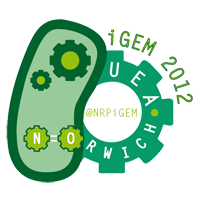Team:NRP-UEA-Norwich
From 2012.igem.org
(→NRP UEA iGEM Team 2012 Project Outline) |
|||
| Line 8: | Line 8: | ||
= '''NRP UEA iGEM Team 2012 Project Outline''' = | = '''NRP UEA iGEM Team 2012 Project Outline''' = | ||
| - | [[File:LogoSmall.png | + | [[File:LogoSmall.png|right|The NRP-UEA iGEM2012 Logo]] |
The iGEM 2012 team for the Norwich Research Park and University of East Anglia (NRP UEA) are a group of seven biology-based undergraduate students working in the labs within UEA’s BIO building. We have been looking at the role of nitric oxide (NO) in biological systems and are aiming to produce a BioBrick that can sense NO within an environment, report on the levels, and go on to make relevant and desirable changes. | The iGEM 2012 team for the Norwich Research Park and University of East Anglia (NRP UEA) are a group of seven biology-based undergraduate students working in the labs within UEA’s BIO building. We have been looking at the role of nitric oxide (NO) in biological systems and are aiming to produce a BioBrick that can sense NO within an environment, report on the levels, and go on to make relevant and desirable changes. | ||
Revision as of 11:24, 16 July 2012
 "
"




